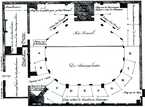EN
history of the theatresupplementtechnical dataHistoric equipmentMunicipal Theatre
Jacob van Campen
alias Schouwburg Van Campen, StadsschouwburgKeizersgracht 384, | |
| show on the map | http://en.wikipedia.org/wiki/Schouwburg_of_Van_Campen |
Important events
(detail)26.12.1637 | opening
Opened with a play Gijsbrecht van Aemstel by Vondel that was specially written for the occasion.
(detail)1665 | alteration
In 1665 van Campen's theatre was rebuilt by Jan Vos with a contemporary-style Italian proscenium arch flanked stage, and painted canvas scenery.
People
(detail)Jacob van Campen |main architect
Dutch architect, the designer of the first theatre in Amsterdam, the Schouwburg, which opened on 3 Jan. 1638 with an historical tragedy, Gijsbrecht van Amstel, by Joost van den Vondel (q.v.). Modelled on Palladio's Teatro Olimpico in Vicenza, it had an elaborate scena stabile, or permanent setting, with a balcony on each side and no proscenium arch, one ceiling covering both auditorium and stage, and a central arch reminiscent of the earlier open-air stages of the Rederijkers (q.v.).
IN: Hartnoll, Phyllis, ed. The concise Oxford companion to the theatre. 1st ed. London: Oxford University Press, 1972. ISBN 0-19-281102-9. p. 82 - 83
History
Additional information
No information has yet been entered
Add information









